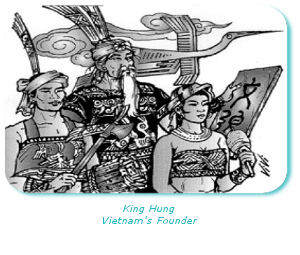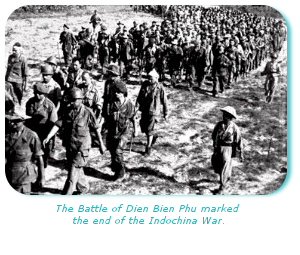From tales to the Doi Moi, the evolution of Viet Nam, a nation of strong character
Telling you the detailed history of my country is not my goal. You will find without any doubt all the major dates and important events elsewhere. I would simply like to underline here some of the features I consider necessary in order to take on a successful cultural trip in Viet Nam. The evolution of Viet Nam is mostly linked to its founding tales and folklores. Unlike some of the countries from Oceania or America, the history is as rich and ancient as the Western, Egyptian and Greek civilizations.
Two opposite kingdoms
The history of Viet Nam is punctuated with Chinese dominations and popular uprisings allowing them to untie from those dominations at certain times. Viet Nam has not been united always, on the contrary: the North and the South are historically two opposite kingdoms:
![]() In the South, the Chams territory used to spread until the Highlands and the Clouds Pass;
In the South, the Chams territory used to spread until the Highlands and the Clouds Pass;
![]() In the North, the Chinese colonization has been quite important : as can still be seen the numerous minority ethnicities coming from Laos, China, Thailand or Burma who still live nowadays on the highest summits of Viet Nam.
In the North, the Chinese colonization has been quite important : as can still be seen the numerous minority ethnicities coming from Laos, China, Thailand or Burma who still live nowadays on the highest summits of Viet Nam.
From the Hungs Kings dynasty to the Chinese Nam Viet
 Everything started with the Dynasty of the eighteen Hung kings, direct descendants of the union between a dragon and an immortal. The country was then called the Van Lang. The time is around 4000 BCE (see key notes). Even nowadays, the Vietnamese people go on pilgrimage to the Hung mount, in Co Tich (80km up north from Ha Noi), on the 10th day of the 3rd lunar month. A rival kingdom, the Au Lac, takes possession of the Van Lang in 257 BCE and makes Co Loa its capital on the advices given by a genius, the Golden Tortoise (see key notes). Even today the Co Loa village, in the immediate area of Ha Noi, still shelters the remains of the fortified city, the capital of the Au Lac kingdom. A hundred years later, the Nam Viet, a southern Chinese kingdom takes hold of the Au Lac kingdom until the Clouds Pass and will keep the nation hold for over a thousand years. The Mandarin established itself in writing along with the philosophy of the ‘’Middle Empire’’: Confucianism, Taoism then Buddhism. Meanwhile, in the southern part of the country, the Khmers and Chams people emerge from the Mekong Delta through the Annam door. Coming from India, they worship the Shiva goddess and write their sacred texts and memoirs in Sanskrit.
Everything started with the Dynasty of the eighteen Hung kings, direct descendants of the union between a dragon and an immortal. The country was then called the Van Lang. The time is around 4000 BCE (see key notes). Even nowadays, the Vietnamese people go on pilgrimage to the Hung mount, in Co Tich (80km up north from Ha Noi), on the 10th day of the 3rd lunar month. A rival kingdom, the Au Lac, takes possession of the Van Lang in 257 BCE and makes Co Loa its capital on the advices given by a genius, the Golden Tortoise (see key notes). Even today the Co Loa village, in the immediate area of Ha Noi, still shelters the remains of the fortified city, the capital of the Au Lac kingdom. A hundred years later, the Nam Viet, a southern Chinese kingdom takes hold of the Au Lac kingdom until the Clouds Pass and will keep the nation hold for over a thousand years. The Mandarin established itself in writing along with the philosophy of the ‘’Middle Empire’’: Confucianism, Taoism then Buddhism. Meanwhile, in the southern part of the country, the Khmers and Chams people emerge from the Mekong Delta through the Annam door. Coming from India, they worship the Shiva goddess and write their sacred texts and memoirs in Sanskrit.
‘’Dai Viet’’ and ‘’Nam Tien’’ marking the eras
In the middle of the 10th Century, Nam Viet becomes Dai Viet as a result of a popular revolution. Three dynasties succeed each other in less than a hundred years. The independence will be gained in 1009 during Ly Thai To’s advent thus making Thang Long its capital (the future Ha Noi, see key notes). The Vietnamese history thus bears the marks for centuries of two goals:
![]() The ‘’walk to the South’’ (Nam Tien), initiated by the General Le Qui Ly, who became the emperor Le Qui Ly in 1400 in order to retrieve the most fertile lands of the country.
The ‘’walk to the South’’ (Nam Tien), initiated by the General Le Qui Ly, who became the emperor Le Qui Ly in 1400 in order to retrieve the most fertile lands of the country.
![]() The defense of the North and of the Red River’s mouth in Hai Phong, successively against the Chinese invaders and the Mongols in the 13th Century.
The defense of the North and of the Red River’s mouth in Hai Phong, successively against the Chinese invaders and the Mongols in the 13th Century.
The Nguyen dynasty and the Romanization of language
 During the 16th Century, the Nguyen rise up against Hanoi central domination with the Le and the Trinh. They are based on lands stolen from the Chams and declare themselves as an independent fiefdom. Hue becomes the capital of their empire, from where they will send raids to the South before taking hold of the Mekong Delta. The Hoi An harbor allow them thus to prosper thanks to the international exchanges with the Portuguese (who own the Macao and Goa trading-posts), the Chinese, the Malay and the Japanese. The opening of the country is such that merchants and corporations settle there closely followed by the first Franciscan and Jesuit missionaries. This was the time of the ‘’Romanization’’ of the Vietnamese language, legacy from Alexandre de Rhodes’ father. From the French colonization to Ho Chi Minh’s resistance, the unification of Viet Nam by Gia Long Emperor in 1802 does not manage to slow down the expansion of western colonialism. The French take hold of Saigon, the Khmer kingdom in Angkor and Laos in order to create the Cochin China. By carrying on their walk to the North, they will alternately take possession of the Annam, the ancient Chams Kingdom in the Middle part, and of the Tonkin, in the end forming Indochina. Under the French occupation, a young man named Nguyen Tat Thanh got on board to Marseille. He will study in Paris, in New York and in London before arriving in Moscow in 1923. In 1942, he will be known from all with his war name: Ho Chi Minh, leader of the Viet-minh troops, the Vietnamese resistance.
During the 16th Century, the Nguyen rise up against Hanoi central domination with the Le and the Trinh. They are based on lands stolen from the Chams and declare themselves as an independent fiefdom. Hue becomes the capital of their empire, from where they will send raids to the South before taking hold of the Mekong Delta. The Hoi An harbor allow them thus to prosper thanks to the international exchanges with the Portuguese (who own the Macao and Goa trading-posts), the Chinese, the Malay and the Japanese. The opening of the country is such that merchants and corporations settle there closely followed by the first Franciscan and Jesuit missionaries. This was the time of the ‘’Romanization’’ of the Vietnamese language, legacy from Alexandre de Rhodes’ father. From the French colonization to Ho Chi Minh’s resistance, the unification of Viet Nam by Gia Long Emperor in 1802 does not manage to slow down the expansion of western colonialism. The French take hold of Saigon, the Khmer kingdom in Angkor and Laos in order to create the Cochin China. By carrying on their walk to the North, they will alternately take possession of the Annam, the ancient Chams Kingdom in the Middle part, and of the Tonkin, in the end forming Indochina. Under the French occupation, a young man named Nguyen Tat Thanh got on board to Marseille. He will study in Paris, in New York and in London before arriving in Moscow in 1923. In 1942, he will be known from all with his war name: Ho Chi Minh, leader of the Viet-minh troops, the Vietnamese resistance.
Indochina ideological warfares
 The maquis fighters give support to Ho Chi Minh until the taking over of Hanoi on September 2nd 1945, where he proclaims the Democratic Republic of Viet Nam (DRV). Despite a real desire to cease hostilities, the war takes over a few days later against France who made alliance with the United States. The DRV finds allies with China and the USSR. The ‘’Iron Curtain’’ settles in Asia. After the bombing of Hai Phong, after the napalm, the Hoa Binh surrender and the Dien Bien Phu battle, the departure of the French troops is signed in Geneva in 1953. The 900 000 anti-communists Vietnamese of the North move over to the American protectorate in the South. The second war involve the American troops to the ‘’Viet-congs’, the National Front of Liberation. During the attacks of the ‘’agent Orange’’ and the bombings, the resistance takes shelter in the tunnels of Cu Chi and Vinh Moc, before launching the Tet offensive in 1968. The destruction of the imperial city of Hue and the attack of the American embassy in Saigon precipitate the departure of the American troops in 1975. The reunification of the country gives birth to the Socialist Republic of Viet Nam.
The maquis fighters give support to Ho Chi Minh until the taking over of Hanoi on September 2nd 1945, where he proclaims the Democratic Republic of Viet Nam (DRV). Despite a real desire to cease hostilities, the war takes over a few days later against France who made alliance with the United States. The DRV finds allies with China and the USSR. The ‘’Iron Curtain’’ settles in Asia. After the bombing of Hai Phong, after the napalm, the Hoa Binh surrender and the Dien Bien Phu battle, the departure of the French troops is signed in Geneva in 1953. The 900 000 anti-communists Vietnamese of the North move over to the American protectorate in the South. The second war involve the American troops to the ‘’Viet-congs’, the National Front of Liberation. During the attacks of the ‘’agent Orange’’ and the bombings, the resistance takes shelter in the tunnels of Cu Chi and Vinh Moc, before launching the Tet offensive in 1968. The destruction of the imperial city of Hue and the attack of the American embassy in Saigon precipitate the departure of the American troops in 1975. The reunification of the country gives birth to the Socialist Republic of Viet Nam.
The Postwar: from Pol Pot to the ‘’Doi Moi’
In 1977, Pol Pot and the Red Khmers of Cambodia supported by China, attack Vietnam. The latter, supported by the SoViet Union, retaliates and invades Phnom Penh in 1979. The occupation will last 10 years and will be criticized all around the globe. Once the order and calm restored, the Party can initiate national reconstruction. In 1986, the government launches a politic of economic revival, the ‘’Doi Moi’’. It is about privatizing the means of production and to liberalize the Vietnamese countryside to increase production in order to insure a degree of food self-sufficiency in the first instance. By 1992, trades with China have been growing strongly. In 1995, Viet Nam joins the ASEAN and re-establishes diplomatic relationship with the United States.




